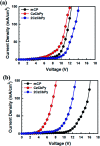δ-Carboline-based bipolar host materials for deep blue thermally activated delayed fluorescence OLEDs with high efficiency and low roll-off characteristic
- PMID: 35539237
- PMCID: PMC9080409
- DOI: 10.1039/c8ra01761a
δ-Carboline-based bipolar host materials for deep blue thermally activated delayed fluorescence OLEDs with high efficiency and low roll-off characteristic
Abstract
Two bipolar host materials, 8-(9H-carbazol-9-yl)-5-(pyridin-2-yl)-5H-pyrido[3,2-b]indole (CzCbPy) and 5-(6-(9H-carbazol-9-yl)pyridin-2-yl)-8-(9H-carbazol-9-yl)-5H-pyrido[3,2-b]indole (2CzCbPy), were synthesized for deep blue thermally activated delayed fluorescence organic light emitting diodes (TADF OLEDs). Both CzCbPy and 2CzCbPy hosts possess bipolar characteristic with high polarity, which results in high delayed photoluminescence quantum yields by reducing the energy gap between singlet and triplet states of TADF materials. In addition, these hosts have high enough triplet energies of 3.05 eV to transfer exciton energy to a deep blue TADF emitter. A deep blue TADF OLED fabricated with a CzCbPy host exhibited high external quantum efficiency of 22.9% and low efficiency roll-off (19.2% at 1000 cd m-2).
This journal is © The Royal Society of Chemistry.
Conflict of interest statement
There are no conflicts to declare.
Figures








Similar articles
-
Universal Host Materials for High-Efficiency Phosphorescent and Delayed-Fluorescence OLEDs.ACS Appl Mater Interfaces. 2015 Dec 2;7(47):26206-16. doi: 10.1021/acsami.5b08291. Epub 2015 Nov 18. ACS Appl Mater Interfaces. 2015. PMID: 26544965
-
Highly Efficient Solution-Processed Thermally Activated Delayed Fluorescence Bluish-Green and Hybrid White Organic Light-Emitting Diodes Using Novel Bipolar Host Materials.ACS Appl Mater Interfaces. 2019 Dec 11;11(49):45939-45948. doi: 10.1021/acsami.9b14168. Epub 2019 Dec 2. ACS Appl Mater Interfaces. 2019. PMID: 31724847
-
Aryl-Annulated [3,2-a] Carbazole-Based Deep-Blue Soluble Emitters for High-Efficiency Solution-Processed Thermally Activated Delayed Fluorescence Organic Light-Emitting Diodes with CIEy <0.1.ACS Appl Mater Interfaces. 2021 Dec 29;13(51):61454-61462. doi: 10.1021/acsami.1c15659. Epub 2021 Dec 16. ACS Appl Mater Interfaces. 2021. PMID: 34913684
-
High Performance Thermally Activated Delayed Fluorescence Sensitized Organic Light-Emitting Diodes.Chem Rec. 2019 Aug;19(8):1611-1623. doi: 10.1002/tcr.201800148. Epub 2018 Dec 10. Chem Rec. 2019. PMID: 30537430 Review.
-
Recent Progress of Singlet-Exciton-Harvesting Fluorescent Organic Light-Emitting Diodes by Energy Transfer Processes.Adv Mater. 2019 Aug;31(34):e1803714. doi: 10.1002/adma.201803714. Epub 2019 Feb 13. Adv Mater. 2019. PMID: 30761642 Review.
Cited by
-
High-performance inverted organic light-emitting diodes with extremely low efficiency roll-off using solution-processed ZnS quantum dots as the electron injection layer.RSC Adv. 2019 Feb 19;9(11):6042-6047. doi: 10.1039/c8ra10290b. eCollection 2019 Feb 18. RSC Adv. 2019. PMID: 35517305 Free PMC article.
-
Conformational Dependence of Triplet Energies in Rotationally Hindered N- and S-Heterocyclic Dimers: New Design and Measurement Rules for High Triplet Energy OLED Host Materials.Chemistry. 2021 Apr 12;27(21):6545-6556. doi: 10.1002/chem.202100036. Epub 2021 Mar 10. Chemistry. 2021. PMID: 33560550 Free PMC article.
-
Base-promoted cascade β-F-elimination/electrocyclization/Diels-Alder/retro-Diels-Alder reaction: efficient access to δ-carboline derivatives.Chem Sci. 2022 Aug 15;13(35):10448-10454. doi: 10.1039/d2sc03166c. eCollection 2022 Sep 14. Chem Sci. 2022. PMID: 36277643 Free PMC article.
References
LinkOut - more resources
Full Text Sources
Miscellaneous

